In today’s world, improving image optimization for SEO is crucial. Using high-quality images that are optimized can make your site look better. They also help with enhancing loading times and improve your site’s performance. This improvement is essential for a better search ranking. Platforms like Brightspot have started using WebP. This format makes photos look good without slowing down your site.
Knowing how images influence SEO can boost user engagement. It’s not just about looking nice. You need to choose the right file names and use responsive design. This makes sure that your images help your site’s SEO score.
Google now pays a lot of attention to user experience when ranking sites. If your site’s images load fast, users will enjoy using your site more. This can mean they stay longer and engage more with your content. Plus, by optimizing images, you can save money on storage and bandwidth.
Key Takeaways
- Web image optimization is key for faster loading times and a better user experience.
- Using WebP can keep images looking sharp while helping your site run smoothly.
- Well-optimized images can push your site higher up in search results, bringing in more visitors.
- Search engines prefer sites with optimized images that are responsive and have correct alt text.
- Smart image optimization leads to savings by lowering the need for disk space and bandwidth.
- Quality images that are properly tagged can make your SEO efforts more effective.
Understanding the Importance of Image Optimization for SEO
Using optimized images is key for better site speed and SEO. Importance of images in SEO is huge because they help keep users engaged. This is important since search engines look at user engagement when ranking sites.
What Is Image Optimization?
Image optimization means making images smaller in size without losing quality. This helps websites load faster. It’s done by choosing the right file format, compressing images, and making sure they fit well in their spots.
How Image Optimization Affects Page Load Speed
Images that are optimized make websites load faster. This is important for SEO and making users happy. If images aren’t optimized, they can slow down a website. This might lead to users leaving the site.
| Image Format | File Size Efficiency | Best Use |
|---|---|---|
| JPEG | Highly efficient | Photographs with complex gradients |
| PNG | Moderate efficiency, supports transparency | Graphics with solid colors |
| WebP | Superior efficiency | Overall web usage |
Optimizing images for all devices improves access and happiness. Using different formats helps websites load faster. This is good for keeping visitors and doing well in SEO rankings.
Optimized images make websites fast, good-looking on devices, and rank better. This shows how crucial importance of images in SEO is. They impact how users behave and how search engines see sites.
Best Practices for Optimizing Images
Digital content now leads the way in grabbing user attention. Because of this, using SEO image optimization tips is key. These tips not only make your website look better. They also make it work better. This ensures faster loading times and a higher spot in search results.
Choosing the Right File Format
It’s vital to pick the right image format for your website’s success. Google supports many formats like JPEG, PNG, WebP, and SVG. JPEG is great for photos because it balances quality and size well. Use PNG for images that need transparency. WebP is a good choice for high quality and small size—it’s 25-34% smaller than JPEGs. SVGs work best for logos and icons because they’re scalable and small.
Resizing Images for Web Use
Another important step is image compression for SEO by resizing images. Big images can slow down your site, hurting the user’s experience. Make sure images are the right size for your site to avoid long loading times. The best resolution for online images is about 72 DPI. And the width shouldn’t be over 2,500 pixels.
Compressing Images Without Losing Quality
Compressing images right means less file size but the same quality. This makes websites faster. Adobe Photoshop has options to reduce file size without losing visual quality. Plugins like WP Smush or TinyPNG can help compress images easily. Switching to formats like WebP can also improve compression and quality over older types.
Putting these SEO image optimization tips into action will make your site look and load better. It will also improve how users and search engines see your site. By focusing on file format, resizing, and compression, you can make your website perform better and rank higher in search engine results.

Utilizing Alt Text Effectively
Alt text is key for web access and improving site search rankings. It describes images for search engines and tools for the visually impaired. Good image alt text optimization also boosts SEO. It helps make the web more accessible for everyone.
What Is Alt Text?
Alt text goes with HTML images to tell us what they show. It’s important for image alt text optimization, helping search engines find images. It also helps when images can’t load, giving users a description.
How to Write Effective Alt Text
To write good alt text, be both descriptive and to the point. Use relevant keywords but avoid stuffing. Here’s how you can make your alt text useful:
- Keep it under 125 characters, being accurate and brief.
- Fit keywords in naturally, matching the image and content.
- Stay clear from stuffing too many keywords.
- Show what the image looks like and its role in the content.
Good practices in alt text serve two roles. They make content accessible and boost a site’s search rankings.
“Alt text can significantly increase website visibility in search results, driving more traffic to the site.”
| Statistic | Detail |
|---|---|
| Alt text in SEO effectiveness | Boosts organic traffic by helping images rank in search. |
| Accessibility compliance | 12 million web users are visually impaired, underscoring alt text’s importance. |
| Accessibility Errors | 61% of homepage accessibility mistakes are due to missing alt text. |
| Litigation Risk | U.S. sees about 10 web accessibility lawsuits daily in 2021. |
Strong image alt text optimization strategies improve SEO, legal compliance, and reach, especially for those with special needs.
The Role of Image Sitemaps in SEO
Image sitemaps are crucial for a strong SEO strategy. They help search engines find and index images better. This boosts a business’s online visibility and attracts more viewers to their digital content.
What Is an Image Sitemap?
An image sitemap is an XML file that makes it easier for search engines to find images. It’s very important for images hidden in scripts or hard to find by normal means. With an image sitemap, every image, including vital SEO names, is included.
How to Create an Image Sitemap
To create an image sitemap, list every image with important details. These details should include the image URL, a clear title, and other information like captions or location. This helps in indexing and improves navigation for visitors. It makes the user experience better.
For sites with many images, like those in SaaS or tech, tools like Yoast SEO can automate sitemap creation. These tools automatically add images to the XML sitemap when uploaded. This keeps the sitemap current without needing to manually update it.
| Feature | Benefits |
|---|---|
| Comprehensive Image Details | Enhances discoverability and context for search engines |
| Automatic Updates | Ensures all new images are immediately indexed |
| Geo-Location Data | Improves local search relevance for global audiences |
| Detailed Captions and Titles | Boosts accessibility and SEO potential |
Using the best practices for SEO image names and keeping the sitemap fresh improves image search visibility. This leads to more engagement and higher conversion rates. Businesses should also send their sitemaps to search engines regularly. They need to check for errors to make sure every image is indexed right.
Leveraging Responsive Images for Better SEO
Understanding how images improve SEO leads us to value responsive web design for images. It makes the user experience better on different devices. This is key since people use varied screens to visit websites today.
What Are Responsive Images?
Responsive images change size smoothly to match any device’s screen. This way, they keep looking good without slowing the site down. Keeping pages loading fast is essential to keep people interested. Big images that load slowly can turn users away and hurt SEO.
Benefits of Using Responsive Images
The role of images in SEO is huge, more so now with search engines focusing on mobile-first indexing. Responsive images help sites load quickly and improve how they look on phones. This boosts SEO rankings. Using the right image format and compression makes websites work well everywhere.
To see how responsive images work well, look at this example of better user experience and its benefits:
| Benefit | Impact on SEO |
|---|---|
| Faster Load Times | Improves site speed, reducing bounce rates |
| Better User Experience | Increases user engagement and time on site |
| Improved Accessibility | Helps in achieving ADA compliance and enhances SEO |
| Enhanced Mobile Experience | Boosts mobile search rankings due to better performance on mobile devices |
| Efficient Data Use | Conserves data use, which is crucial for users on limited or slow connections |
Focusing on the importance of images in SEO with responsive web design for images meets both looks and SEO needs. This method boosts visibility, user interaction, and the overall success of online content on various platforms.
Tools and Resources for Image Optimization

Optimizing your website’s SEO means using best practices for images. It’s essential to have the right tools. In this section, we’ll look at top image optimization tools. We’ll also see how WordPress plugins make this easier.
Popular Image Optimization Tools
Image optimization tools help make your site faster and boost SEO. Tools like ImageOptim, Kraken, and Photopea offer compression, resizing, and more. They make images SEO-friendly, using formats like WebP and AVIF. For example, Kraken is great for compressing many images without losing quality.
- TinyPNG uses smart lossy compression techniques to reduce the file size of PNG files.
- Optimole automates image resizing and compression, delivering optimized images based on the visitor’s device.
- Webflow isn’t just for web design. It’s also great for converting images to advanced formats like WebP and AVIF.
Image Optimization Plugins for WordPress
For WordPress users, image optimization plugins can make things much smoother. Plugins like EWWW Image Optimizer, ShortPixel, and WP Smush work well with WordPress. They offer automatic compression and ensure images are the right size when uploaded.
- EWWW Image Optimizer optimizes images as you upload them and can improve previously uploaded images too.
- ShortPixel uses advanced compression technology to make images smaller without losing quality.
- WP Smush lets users bulk smush up to 50 images at once, saving time for those with lots of images.
Using these plugins helps follow image SEO best practices, boosting your site’s SEO. Optimizing images speeds up page loads and increases user engagement. This leads to better SEO rankings.
Monitoring and Measuring Your Image Optimization Success
Exploring SEO means watching performance closely and adapting. It’s key to check how well your strategies optimize images for search engines. Realizing that about a quarter of searches happen on Google Images shows the need to optimize, especially for businesses like stock photo sites and art galleries.
Key Metrics to Track
Success measurement starts with following key performance indicators (KPIs) using reliable tools such as Google PageSpeed Insights and GTmetrix. These tools show the impact of image optimization on website speed, which is vital for SEO ranks. It’s important to note how images drive traffic and possibly improve conversion rates, especially if they help explain or entertain. Make sure your images are easy for search engines to find and list, including in your XML sitemaps.
Adjusting Strategies Based on Performance Data
Using performance data to make changes is crucial for improving image optimization. If outcomes aren’t as expected, check if alt texts follow SEO rules, if images match their content, and if you’re using the best formats like JPEG, PNG, WebP, or SVG. Smart use of image compression tools like TinyPNG and prioritizing quick loading and responsiveness will help lower website bounce rates and increase conversions. Proper optimization benefits user experience, boosts content visibility, and strengthens online presence.
FAQ
What Is Image Optimization?
Image optimization makes sure images are the right format, size, and resolution. They also need correct labeling. This improves page loading speed, enhances user experience, and helps SEO rankings.
How Does Image Optimization Affect Page Load Speed?
With optimized images, web pages load faster. This is because the images are smaller in size. Quick loading improves user experience and can help with search engine rankings.
What Are the Best Practices for Choosing the Right File Format?
The best format for complex images with many colors is JPEG. For simpler images, PNG is better. Choosing correctly helps keep image quality high and file size low.
Why Is Resizing Images for Web Use Important?
Resizing images means they’re not too big for the web. This leads to faster load times. Your website works better without losing image quality.
How Can Images Be Compressed Without Losing Quality?
You can compress images with Adobe Photoshop or online tools. Tools like TinyPNG or WP Smush adjust size and quality without ruining the image.
What Is Alt Text?
Alt text is a short description for images. It gives context and helps with SEO. This makes the image content clear to search engines.
How Should You Write Effective Alt Text?
Write alt text that describes what’s in the image. Use keywords, but don’t overdo it. This makes your site better for SEO and accessible to more users.
What Is an Image Sitemap?
An image sitemap is a file that lists all images on a site. It includes titles, descriptions, and URLs. This helps search engines find your images better.
How Do You Create an Image Sitemap?
You can make an image sitemap by hand or use SEO plugins. Plugins like Yoast SEO automatically add your images to sitemaps.
What Are Responsive Images?
Responsive images change size based on the device’s screen. This ensures that everyone has a great experience, no matter the device.
What Are the Benefits of Using Responsive Images?
Responsive images load quickly on mobile devices. They make your site better to use and help with SEO, especially on Google’s mobile-first indexing.
What Are Some Popular Image Optimization Tools?
Tools like Adobe Photoshop, ImageOptim for Mac, Kraken.io online, and Photopea are great for optimizing images. Each has special features for making images web-ready.
What Image Optimization Plugins Are Available for WordPress?
WordPress has plugins like EWWW Image Optimizer, ShortPixel, and WP Smush. These help make optimizing images automatic and improve SEO.
What Are the Key Metrics to Track for Image Optimization Success?
Track how fast your page loads, how much you’ve reduced image sizes, and your search engine rankings. These show how well your image optimization is working.
How Should Strategies Be Adjusted Based on Performance Data?
Adjust your strategy based on data. Change compression levels, switch file formats if needed, and update alt text. This keeps your optimization top-notch.



